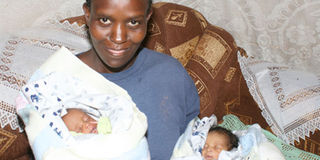Rural women die while giving birth

Photo/JENNIFER MUIRURI
Ms Purity Njeri, 27, from Uthiru, holds her seven day old twins Agnes Wambui and Margaret Wahu at their home on May 24, 2011.
When she developed pregnancy complications last Tuesday evening, she called a taxi driver to rush her to hospital.
The 27-year -old Purity Njambi wanted to brave the 5pm traffic jam from Uthiru to Pumwani Maternity Hospital.
She hurriedly packed, with the Ante Natal Clinic card at hand, then made a phone call to her husband and gave an assuring glance at relatives before leaving for hospital. She did it all in less than 10 minutes.
“She called and told me that she needed to see the doctor immediately. I left work and met her and the taxi driver at Westlands then we proceeded to hospital,” her husband David Chege told the Nation at their home on Tuesday.
In less than 40 minutes, she was admitted to Pumwani Maternity Hospital and booked for a Caesarean section — a surgical incision through the abdominal and uterine walls in order to deliver a baby.
When she regained consciousness at 8pm, she was the proud mother to twin-daughters Margaret Wahu and Agnes Wambui.
It would have been a different story had Ms Njambi lived in a rural area, even if near a health facility that does not provide Caesarean section services.
The 2010 Kenya Service Provision Assessment Survey released on Tuesday is a catalogue of the disparities in maternal health care across the country that leave women in rural areas vulnerable in an emergency.
According to the report, only five per cent of facilities nationwide can perform a Caesarean section.
Half of those facilities are in Nairobi, which leaves the rest of the country to share 2.5 per cent. It is a drop from the 7 per cent reported by the same study in 2004.
In 2004, only 3 per cent of government facilities performed Caesarean section.
Half the hospitals in Nairobi offer the service compared to Central and Coast provinces ranking second and third at 39 and 32 per cent respectively.
North Eastern Province was ranked fourth at 22 per cent with Western and Eastern Province both ranking fifth at 22 per cent.
Rift Valley recorded 14 per cent while Nyanza ranked last at 13 per cent providing the critical health service.
Maternity emergencies
Transport support for maternity emergencies is also non-existent in half of government facilities surveyed, with Nyanza rated as the province where one is more likely to find a means to the hospital.
The report launched on Tuesday says only half of the 690 health facilities sampled have an ambulance or a system to transfer maternal emergencies to an appropriate facility.
The 2008/2009 Demographic survey noted that more than half of the births in Kenya occur at home.
The report also points out that Ante Natal Counselling for the expectant mother about the warning signs of pregnancy complications, exclusive breast-feeding and family planning after birth was not consistent.
Complications of pregnancy and childbirth are among the leading causes of mortality among women.
Hospital records and hospital-based studies conclude that the majority of these deaths are due to one or more preventable complications like bleeding, rapture of the uterus, severe anaemia and obstructed labour which can be sorted if the mother arrives in hospital in good time.
Ms Njambi said she was lucky that she regularly attended clinic and had been taught by the health workers to recognise the warning signs.
“There are so many myths from fellow women and mothers which you should not trust,” she said and advised mothers the doctors’ advise.
In the past 40 years, the rate of Caesarean deliveries jumped from about 1 out of 20 births to about 1 out of 4 births.
This trend has caused experts to worry that C-section is being done more often than it is needed, especially by town women who have abandoned the push. Experts feel that C-section should only be done for medical reasons.
On Tuesday, Ms Njambi said the plight of her fellow women in the rural areas should be urgently addressed so they can comfortably have access to the very services the urban women enjoy.




